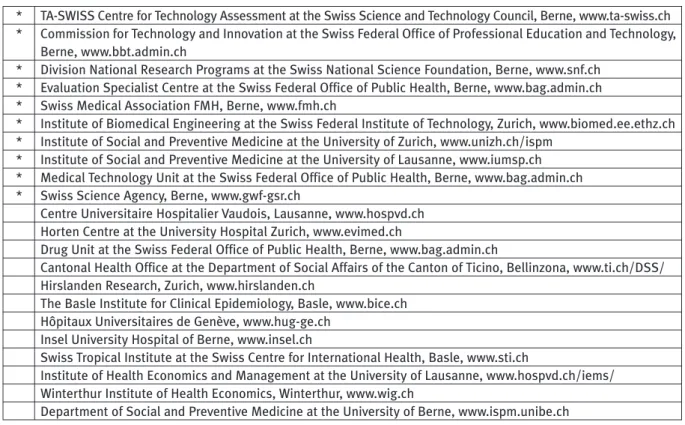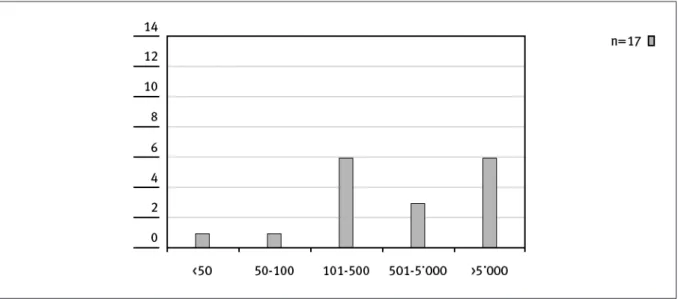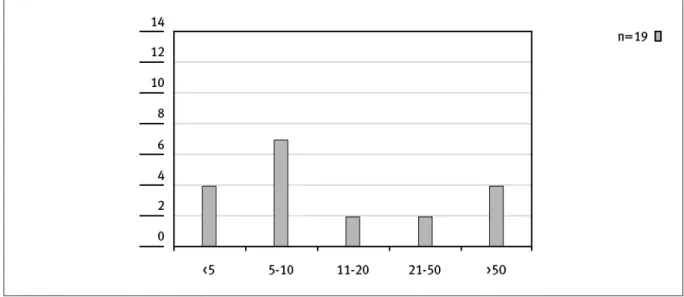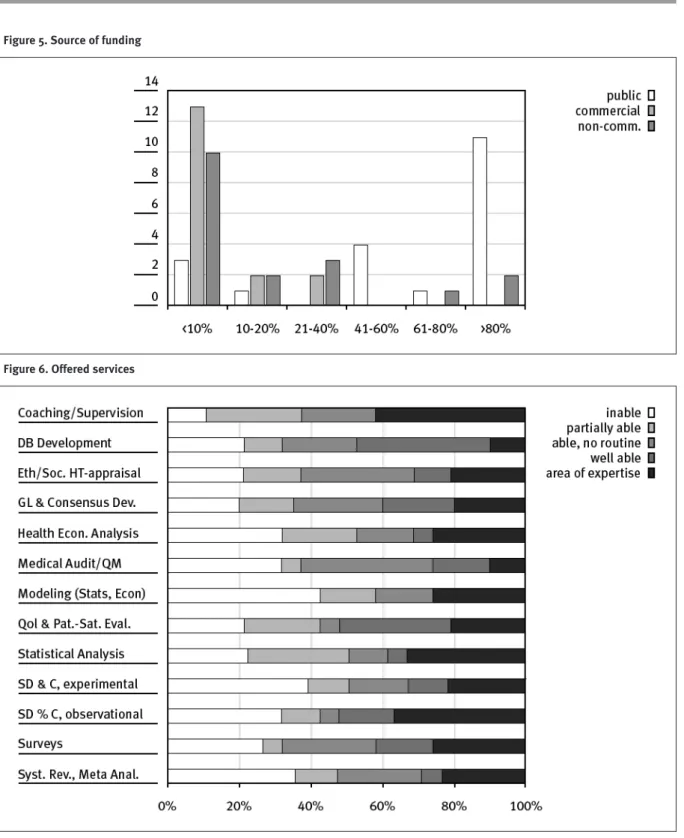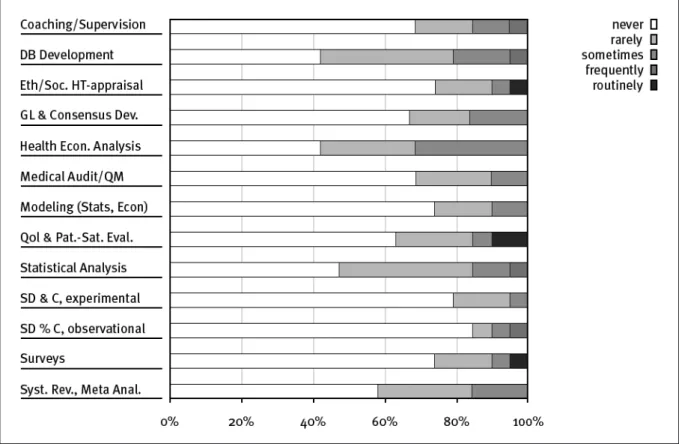Background
Short view of the Swiss health care system
Liberalism and federalism characterise the Swiss political system. Principles of federalism are anchored in the federal constitution. The confederation can only legislate when empowered by the constitution, giving limited power to the confederation over the health care system. These principles result in a complicated system in which many different actors are involved.
The health care system is financed through taxes, out of pocket expenses and from health insurances in equal parts. Compulsory health insurance is offered by private not for profit registered insurance companies. These companies compete not for the quality of services rendered; which are defined by the legislator, but only for premium prices [1].
Federal Authorities decide on the compulsory health benefit package of services to be fully covered by insurances. They include in- and outpatient services as well as long term care and partly nursing homes. High specialty care, like organ transplant procedures and implantable devices, are also included to a great extend.
Additional services can be purchased through private insurances (for profit companies) which cover hospitalization in private hospitals and give direct access to senior physicians.
The political objective
Switzerland’s health care costs are second highest pro capita GDP, worldwide [2]. The constant increase in costs challenges policy makers as much as citizens. Health Technology Assessment (HTA) has been identified very early as an important instrument for evaluation of costs
Switzerland Committed to Innovation. The Swiss Network of Technology
Assessment
Facing the challenges of the 7
thyear
Konrade von Bremen
1, Maya Züllig
2, Georg von Below
3, Felix Gurtner
2, Christoph Künzli
2,
Sergio Bellucci
4, Pedro Koch
21
IEMS University of Lausanne, Lausanne, Switzerland; 2Swiss Federal Office of Public Health Medical Technology Unit, Bern, Switzerland; 3Swiss Medical Association FMH, Bern, Switzerland; 4Centre for Technology Assessment Swiss Science and Technology Council, Bern, Switzerland
Corrispondence to: Konrade von Bremen, IEMS University of Lausanne, César- Roux 19, 1005 Lausanne, Switzerland. E-mail: Konrade.von-Bremen@chuv.ch
Abstract
Switzerland showed its commitment to innovation in health care since the early 80th, implementing agencies and government units with the mission to promote and to appropriately govern innovation. The Swiss Network of Technology Assessment (SNHTA) was founded in 1998. The aim is the promotion and implementation of Health Technology Assessment projects in Switzerland by providing a neutral forum for the identification and the pursuit of common interests. This includes the coordination, exchange and dissemination of experiences of HTA projects and the implementation of the results. The collaboration in international projects is a priority. Ultimately SNHTA has the goal to improve efficacy, cost effectiveness and social accountability. An inventory survey amongst the members confirmed a high level of diverse specialised competencies, mainly employed within the institution. Only 20% of the HTA specific competencies are used for external activities. The need for integration of all partners in the field of innovation in a network has been recognised by the Swiss government. This lead to the creation of a webplatform in which all players involved in the business of medical technologies are involved. This platform (swiss medtech), includes patients, insurers, industry, universities and professional organisations. The joined activities include agreements on intellectual property and the integrated patient care chain. New ways to connect players in innovation are needed to face the challenge of increasing costs and diminishing resources.
and appropriateness of an emerging or existing technology.
Innovation and evaluation of technological innovation has a long standing history in Switzerland. Already in the early 80’s a fully dedicated Medical Technology Unit (MTU) was founded within the former Federal Social Insurance Office reporting directly to the Minister of Home and Social Affairs.
The federal reimbursement system and HTA
The minister of home affairs is the ultimate decision making entity regarding inclusion or exclusion from compulsory reimbursement through insurances. Switzerland is one of the few countries in Europe, where individuals, professional organizations and industry can apply for reimbursement for new drugs, devices or procedures (preventive or diagnostic procedure and rehabilitation).All potential applicants have free access to the transparent processes, a handbook explains all applicable requirements including standardised procedures [3]. The requirements are mostly articulated for procedures and medical devices,and correspond to a full HTA report.Special attention is given to follow up procedures, their potential costs and cost-effectiveness [4-6].
Already in 1996 the MTU has obtained ministerial approval for an innovative way to implement a process giving early technologies the chance to benefit from temporary but compulsory reimbursement. Since 1996 innovative treatments obtain temporary reimbursement under the condition that all parties benefiting form the technology, provide the MTU yearly with faithfully collected medical outcome data and recently also some cost data [7]. At the end of the evaluation period, which can vary between 3 and 5 years, according to the kind of procedure, an updated HTA report has to be submitted to the authorities for final decision [8-10].
The Federal advisory commission (ELK) which evaluates the incoming reports on behalf of the ministry of home affaires, is composed of all relevant players in the health care system, as there are representatives of the insurers, the governing bodies, the professional associations and the patients’ organization.
In 2003 Switzerland was still the only country in Europe which could give full but temporary reimbursement for new and emerging technologies.
Technology Assessment TA- Swiss
The mandate from Government and Parliament
In 1991, the Federal Council and Parliament mandated the Swiss Science Council to create a
‘Swiss model’ to assess the consequences of technology reports to the Swiss Science and Technology Council with the following mission: Provide the general public, the parliament and also the researchers themselves with decision aids for the assessment of the effects of scientific research and technological development.
The aim of TA-Swiss is to ensure objectivity in the socio-political discussion on the positive and negative effects of scientific research and technological developments as or as on the lack of effects, and this in the broadest possible scope. In order to create a constructive dialogue between the public and the scientific community, TA Swiss has developed and implemented innovative participative methods which allow to provide the public and the political authorities with high–quality unbiased information [11].
The Centre for Technology Assessment targets its efforts on fields of technology and their application that are considered by public opinion to be controversial. The Program looks into the subject areas “Life Sciences and Health”, “Information Society” and “Mobility”. TA-SWISS carries out studies on a scientific basis on these subjects. Additionally, TA-SWISS investigates processes that should make it possible for the general public to be involved in technology centred policy decisions.
The mode of operation and instruments of Technology Assessments of TA –Swiss
An interdisciplinary approach is the characteristic of TA institutions. Consequences of new technologies are assessed as comprehensively as possible, they are systematically analysed and examined for possible economic, social and ecological consequences and secondary effects.To do so,TA Swiss uses various forms of participatory procedures (for example, consensus conferences, public forums, or focus groups) to gather the opinions of those affected qualitatively [12].
The perspective of informed laypersons can be included in the evaluation of controversial technologies, so that the evaluation of new tech-nologies is not left up to technicians, sociologists and political scientists. The risk being high, that the opinion of experts deviates diametrically from the affected population. Communication is considered a key element of every TA project. Communication takes place before, during and after the conclusion of the project.
The Swiss Network of Technology Assessment
the TA-Swiss to coordinate the HTA activities in Switzerland and to create the Swiss Network of Technology Assessment, an association comprising Federal Government agencies dealing with technology assessment and research institutes as well as University Institutes and Cantonal Public Health Authorities. (Table 1).
The aim of the SNHTA
• Promote and implement Health Technology Assessment projects in Switzerland.
• Provide a forum for the identification and pursuit of common interests of the member institutions. • Coordinate, exchange and dissemination of
experiences in HTA, to promote of implemen-tation of results.
• Avoid duplication of efforts by collaboration of experts: optimal use of limited resources. • Collaborate in European and other international
networks and projects
The ultimate goal of the SNHTA is to participate in improving efficacy, cost effectiveness and social accountability in health care in Switzerland.
Membership requirements
The SNHTA welcomes members of Swiss institutions involved in the HTA activities, conducting HTA projects on an institutional, regional or national level, review HTA reports or disseminate their findings.
Members have to disclose their sources of funding. Commercial funding is accepted up to 50% of the total funds. It is expected that members share the results of their HTA projects unless they are explicitly confidential. They are also invited to report on their international activities when acting as a representative of the SNHTA.
The organization of the SNHTA
The executive board is composed of two Swiss delegates who represent the network in the international networks acting as Co-Chairs. A network coordinator ensures the activities of the members and the international relations. A representative of one member organization completes the board. The SNHTA meets twice a year in a plenary session.
Funding
The funding for the SNHTA comes from the Ministry of home affairs and covers only the 50% position of the network coordinator. SNHTA does not claim membership fees so far.
All other government and non governmental members are entirely funded through their own institutions. No expense reimbursement is foreseen.
The development of the SNHTA 1999-2004
During the years 1999-2004 the network has met a rapidly growing interest amongst the
Table 1. Member Institutions of the Swiss Network of Technology Assessment SNHTA
* TA-SWISS Centre for Technology Assessment at the Swiss Science and Technology Council, Berne, www.ta-swiss.ch
* Commission for Technology and Innovation at the Swiss Federal Office of Professional Education and Technology,
Berne, www.bbt.admin.ch
* Division National Research Programs at the Swiss National Science Foundation, Berne, www.snf.ch
* Evaluation Specialist Centre at the Swiss Federal Office of Public Health, Berne, www.bag.admin.ch
* Swiss Medical Association FMH, Berne, www.fmh.ch
* Institute of Biomedical Engineering at the Swiss Federal Institute of Technology, Zurich, www.biomed.ee.ethz.ch
* Institute of Social and Preventive Medicine at the University of Zurich, www.unizh.ch/ispm
* Institute of Social and Preventive Medicine at the University of Lausanne, www.iumsp.ch
* Medical Technology Unit at the Swiss Federal Office of Public Health, Berne, www.bag.admin.ch
* Swiss Science Agency, Berne, www.gwf-gsr.ch
Centre Universitaire Hospitalier Vaudois, Lausanne, www.hospvd.ch
Horten Centre at the University Hospital Zurich, www.evimed.ch
Drug Unit at the Swiss Federal Office of Public Health, Berne, www.bag.admin.ch
Cantonal Health Office at the Department of Social Affairs of the Canton of Ticino, Bellinzona, www.ti.ch/DSS/
Hirslanden Research, Zurich, www.hirslanden.ch
The Basle Institute for Clinical Epidemiology, Basle, www.bice.ch
Hôpitaux Universitaires de Genève, www.hug-ge.ch
Insel University Hospital of Berne, www.insel.ch
Swiss Tropical Institute at the Swiss Centre for International Health, Basle, www.sti.ch
Institute of Health Economics and Management at the University of Lausanne, www.hospvd.ch/iems/
Winterthur Institute of Health Economics, Winterthur, www.wig.ch
Department of Social and Preventive Medicine at the University of Berne, www.ispm.unibe.ch
scientific community. It doubled its member organizations by end of 2004 including now almost every relevant research institutions. The voluntary nature of the network shows the attractiveness of this loose network structure.
This unforeseen interest can be attributed to the fact that economic constraints had by that time reached all health care institutions in the country. Measures to face the dilemma between quality of care and cost effectiveness had to be found. The limited specialized competencies in each institution and the allocation of the scarce resources, made it more and more evident that only effective collaboration would help to overcome this hurdle.
The 7thyear, the inventory approach
In order to better understand the context and competencies of the network member institutions the new executive board together with a working group, developed a survey for this purpose.
The results of the survey were collected via invitation letter and solicited by telephone.
The inventory survey
The questionnaire was divided into two sections:
1) the institutional characteristics, mission, size
and main activities (ranked) and HTA dedicated personnel, their public or private assignments and the position of the SNHTA member and his or her substitute within the institution.
2) the competencies, HTA related services
provided within the institution were requested, using a ranking system from 1-5, being 1 the most provided and 5 never. Cost-effectiveness analysis, Cost-utility analysis, cost minimisation analysis and cost-benefit analysis; systematic
review of the literature and medical audit. Epidemiological studies, statistical services, econometrics and clinical guideline elaboration. Evaluation registries, data base elaboration and analysis, clinical studies, piggy back studies, satisfaction studies and quality of life studies. Coaching and supervision of one or more of the above was also included.
The survey asked for the portfolio of HTA services most likely to be acquired externally.
The results of the survey
The number of people dedicated to HTA activities is independent from the size of an institution and its mission as shown in Figure 1 and 2.
Eleven institutions had up to 10 people dedicated to HTA activities, while only four had more than 50 people involved in HTA (not necessarily full time) (Figure 2).
The majority of the SNHTA members are involved in teaching, training and research or public administration. A very small number of institutions are also involved in clinical activities and hospital management. The consulting activities and internal vs external mandates of the members are shown in Figure 3. It clearly appears that for most institutions, 80% of the working capacity is dedicated to internal mandates and only 20% to external activities. Not surprisingly these results are confirmed by the same ratio of funding (Figure 4). The portfolio of expertises of our members in Figure 5 shows, that the diversity of highly specialised competencies covers nearly all areas requested.Teaching and supervision, was the only competence in common for all members. Between offered and acquired services seems to
Figure 2. Size of HTA-Team within institution (head count)
Figure 3. Main activities of member institutions
be a breach. Most services are provided internally and only highly specialised competencies are acquired (Figure 6 and 7).
Other countries and experiences
The health technology movement has now reached across the developed world a certain level of maturity. After years of method finding, struggling about structures now comes the time that structures are asked to show their results. [13]. In big countries like Canada, dedicated
agencies are considered part of the system [14]. The differentiation of HTA competencies have been recently described [15] for the England and Wales. The three distinct ways of producing HTA correspond to the institutional level (researcher led HTA), the national level (the research and development program) and the NICE reports. These developments well described in other European countries find their correspondence also in small countries like Switzerland and might even go beyond.
Figure 5. Source of funding
Discussion and Conclusions
The early development of technology assessment in Switzerland has shown, that citizens and authorities governing the health care system are strongly committed to innovation. Under the threat of a new law which could hinder the innovation process, a comprehensive report was recently funded through public and private initiatives stating that withholding innovation from the citizens is valued as an important loss [16, 17]. The mechanisms to govern on one hand and to diffuse the understanding of innovation on the other hand have been early put in place through the Medial Technology Unit and the TA Swiss.The track record of these institutions is now fully validated.
The rapid growth of the SNHTA virtual network shows the increasing interest in the field of technology assessment. The survey performed during the summer 2004 amongst the 22 member institutions showed, that there is a broad spectrum of competencies within the network but which are mainly used internally.
Policy implications of HTA are gaining importance. Not only the methodology applied to assess new technologies is established, but also the implementation process is thoroughly built to meet government interests. The Swiss government, all ministries dealing with medical
devices, created a platform for all partners involved in the business of medical technologies. Participants in the platform range from industry, patient organizations, universities and professional organizations (www.swiss-medtech.org). Topics treated in this platform include: intellectual property and integrated patient care. We can conclude, that innovative initiatives have the rare opportunity, in a small country like Switzerland to became national projects. Innovation initiatives have the rare opportunity in a small country like Switzerland to become national projects.
References
1) Minder HS, Amiet M. Health care systems in transition Switzerland. European Observatory on Healthcare, 2000. 2) Kocher G. Zweitteuerstes Gesundheitssystem der Welt. (The second most expensive healthcare system in the world.) Schweizerische Aerztezeitung 2004;40(85):2142-4.
3) Sozialversicherung Bf. Handbuch zur Standardisierung der medizinischen und wirtschaftlichen Bewertung medizinischer Leistungen.( Handbook for the standardization of medical and economic evaluation of medical services.) In: Sozialversicherungen Bf, ed.; 2000.
4) Sozialversicherung Bf. Supplement Kostenfolgen einer neuen Leistung, zum Handbuch zur Standardisierung der medizinischen und wirtschafltichen Bewertung medizinischer Leistungen. In: Leistungen M, ed; 2000.
5) Faisst K, Schilling J, Koch P. Health technology assessment of three screening methods in Switzerland. Int J Technol Assess Health Care 2001;17(3):389-99.
6) Cranovsky R, Schilling J, Faisst K, Koch P, Gutzwiller F, Brunner HH. Health technology assessment in Switzerland. Int J Technol Assess Health Care 2000;16(2):576-90.
7) v. Bremen K.A model for a cost-monitoring registry for
treatment options under compulsory evaluation. In:
International Society of Technology Assessment in Health Care, 19thAnnual meeting, June 2003; 2003; Calgary, Canada; 2003. 8) Zuellig M. Industry collaboration in HTA. In: International Society of Technology Assessment in Health Care HTA; 2004; Krakov, Poland; 2004.
9) M.Zuellig PK. Is temporary insurance coverage under monitoring feasable? In: International Society of Technology Assessment in Health Care,ISTAHC;2003;Canmore,Canada;2003. 10) Zuellig M. Collaboration with Industry between vision and reality: 61/2years of experience of the Federal Social Insurance Office of Switzerland. In: International Society of Technology Assessment in Health Care ISTAHC; 2002; Berlin; 2002. 11) Rippe K. Pharmakogenetik und Pharmakogenomik. (Pharmacogenetics and pharmacogenomics) In: Techno-logiefolgen-Abschätzung Zf, ed.; 2004.
12) TA Swiss.TA Swiss Porträt.Akteure und Abläufe des Zentrums für Technologiefolgen- Abschätzung. (TA Swiss Portrait. Subjects and processes of the Technology Assessment Center). In: Abschätzung ZfT, ed., 2004.
13) Garcia-Altes A, Ondategui-Parra S, Neumann PJ. Cross-national comparison of technology assessment processes. Int J Technol Assess Health Care 2004;20(3):300-10.
14) Lehoux P, Tailliez S, Denis JL, Hivon M. Redefining health technology assessment in Canada: diversification of products and contextualization of findings. Int J Technol Assess Health Care 2004;20(3):325-36.
15) Stevens A, Milne R. Health technology assessment in England and Wales. Int J Technol Assess Health Care 2004;20(1):11-24.
16) Zweifel P.Was leistet unser Gesundheitswesen? (What does our healthcare system offer?) Schweizerische Aerztezeitung 2004;32/33(85):1695-7.
